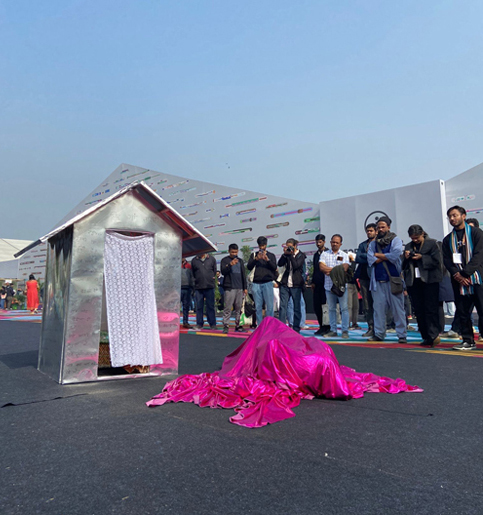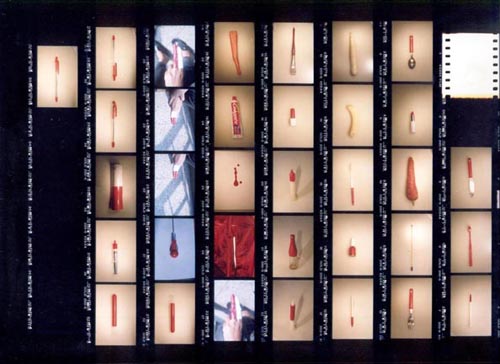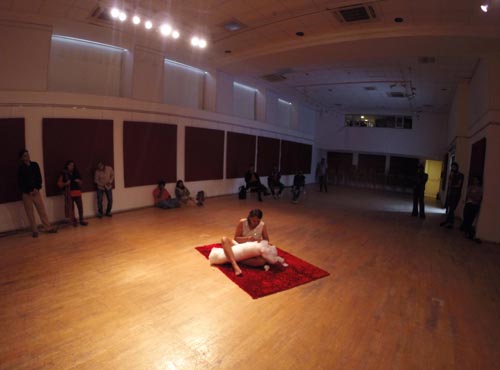Interview with Manmeet Devgun
Colette Copeland
February 2024
 still from the performance‘thaan‘ space/place : searching the self, 2023,
still from the performance‘thaan‘ space/place : searching the self, 2023,
New Delhi Art Fair, Photo by Sajan Mani
I met artist Manmeet Devgun in New Delhi during the Art Fair. I read about her performance event and contacted her through a mutual acquaintance to set up a time to chat. We spent 4 hours in her home studio sharing stories about art, life as a single mother, sex and death. I immediately sensed a strong connection with her and her work. The evening culminated in a recording session that left me in tearful awe. It’s so rare to have a deep, meaningful encounter when meeting someone for the first time. I’m grateful for Manmeet’s trust and honesty in sharing her experiences with me.
CC: Your diverse art practice embodies many forms, exploring themes of home, family, honor, sex, pleasure and death. Upon initial glance, one might not recognize the threads that bind these seemingly disparate subjects. As we discussed your various bodies of work, I began to see the overarching connections between your most recent performance questioning the notion of home/what constitutes a home and your earlier work. The idea of claiming space in the world as a female in India is central to your practice over the past two decades. Please share with us your recent performance project and why you decided to return to performance after a self-imposed break of three years.
MD: My recent performance is titled ‘thaan‘ space/place : searching the self. ‘Thaan’ is a Punjabi word for place/dwelling/space. The performance is about being in a constant place of discomfort, displaced-as a woman/sister/daughter/mother/colleague/lover and the constant struggle to find a comfortable spot to sit or settle down. The need to be accepted and not judged. The work is inspired from a poem I wrote in Punjabi, my mother tongue. I’m asking the questions, “Is there such a place where women are not ridiculed, or abandoned or disowned? Is there a place where we are treated with love, respect, and dignity? These questions are quite relevant in today’s time.
Throughout the performance, I am trying to search for that place as I drag my supposed home/hut/dwelling. Nothing or rather no spot gives me that comfort. I sit for a while, trying to live in the 3.5’x4’ hut and then am pushing it again. The hut/prop is also designed in such a manner that it gives a feeling of a home, but not quite enough space or security. You cannot stand inside fully. There is no privacy and only a small stool for sitting. I try to claim the space around the structure with a pink garden of fabric.
This is my first performance after a 3-year hiatus. I was taking a conscious break, as I was really disappointed with so many things happening in the name of ‘performance’–yet without meaning, depth or sincerity, like an elongated ‘reel’ or ‘TikTok’. I am all for encouraging the medium, but I feel disenchanted at times. Not every gesture is performance, not every act is performance. Social media gives instant visibility encouraging the notion that anything and everything is performance. Performance has never been and should never be about convenience.
Also on the personal front, I was dealing with a post death situation. Quite a painful space. Everything was too overwhelming to create a performance work. I didn’t have the energy or inspiration.
When Jyothidas KV asked me if I’d like to be a part of the Delhi Art Fair program, I was super delighted. I was missing performing. This felt like perfect timing to create a new work.
CC: What does performance give you as an artist that other media does not? And what is the relationship between you as the subject or conduit for the work and the audience?
MD: Performance gives me freedom. Freedom to play around in space. Unlike a canvas or a frame, it does not restrict me. I can walk, scream and/or be still without any expectation. Using minimal materials, I can create. Performance has no demand of perfection. I can falter and continue.
The relationship between me as a subject and the audience is that of a witness. A witness to the emotions shared/created. The audience is a part of it from the start to the end. The audience’s energy becomes part of the work.
In 2015 I did a performance in Zurich entitled I love you. It was a play with words and during the performance a rhythm was created. The audience snapped their fingers and tapped their feet. It was beautiful. It was not meant as an interactive performance, but the audience joined in. There is an exchange of energy I feel with the audience during each performance.
 from the installation Death of Masturbation, mixed media, 2002, photo courtesy of the artist
from the installation Death of Masturbation, mixed media, 2002, photo courtesy of the artist
CC: Let’s talk about sex. I confess that I love to discuss sex, but it is still very much an off-limits subject in India. One that is NEVER discussed in polite company. The one time I made a joke with my male friend here, he was very uncomfortable. Even though it’s more out in the open in the West, it’s still not a subject that comes up every day. You have courageously addressed this taboo subject in your work including the masturbation installation (2002), Female Gaze (2002), and Pleasure (2014). What has been the reaction to these works in India? What gives you the courage to boldly speak out about female sexuality and pleasure?
MD: I love sex! All aspects of it! Despite India being the most populous country in the world, we shy away from talking about sex. I wish we had more erotica (art) around. It is hardly talked about and when one does, there is generally a moralistic judgement to it.
The installation, Death of Masturbation is a mixed media work. It talks about things that give us pleasure/stimulate us sexually, physically and/or intellectually. All the objects are connected by the colors red and white. There is a carrot, radish, pen, toothbrush, book, nail polish, etc. There is a curtain of photographic contact sheets with images of the objects. Some sculptural assemblage objects hang from the photographic installation. I have attempted to create a phallic form with a pair of red panties cut, stitched and inserted with a coke bottle covered with pantyhose.
Here is the text I wrote to give the work more context :
‘commodity; a desire
The piercing touch
A curtain…
To cover
The underlying obsession,
Which recognizes
Objects
After the death of masturbation
The death of consumption
The death of identity
No, its not a sacrifice
Just an obsession
Another outlet-to live
And liberate the sexual self.’
Phallic objects interest me. It is like an arrogant tease.
Throughout art history we come across female nudes. A number of years ago, I came across a book of male nudes by Lucian Freud. What a delight it was. That delight led me to make the video work Female Gaze. The work features me with a magnifying glass slowly traveling over the body of Freud’s nude male subject. I filmed it on a lazy Sunday afternoon and one can hear the ambient sound of the vegetable vendor in the background, adding to the mundanity of the scene.
 still from the performance Pleasure, 2014, Photo by Suresh Kumar G
still from the performance Pleasure, 2014, Photo by Suresh Kumar G
The work Pleasure is a triptych series. The second work in this series was exhibited in Bangalore. The event was titled Illicit Bodies, curated by Suresh Kumar G. For this performance, I stitched a pillow in a phallic shape, lying on a beautiful red carpet and telling the pillow how to please me. There was an audio recording playing, with a computer animated voice, speaking about orgasm, phallus’, sleep, and vaginas. No phone cameras/cameras were allowed in the space.
No one talked about the work after the performance! Everybody just sat and drank tea.
I don’t think I’m courageous when making such works. I just know that I want to create them. Sexuality and pleasure devoid of gender should be spoken about. We all crave sexuality and pleasure, we want to feel it and explore it, so why not create works that address these issues? I suspect people are not comfortable with such works here, and that is the reason they haven’t been exhibited much.
Here is a text I wrote while noticing phallic-looking salt dispensers at a restaurant.
Innocently phallic
They awaited their turns
Ready with the sprinkler
These dick heads
They acted quite strangely this evening
Snuck in the edge
So turned on
And ready to burst
These dick heads
Shinning bright and awaiting stupid
They reeked of phallic arrogance
Like those dumb lovers she had had
Stupid phallic love
Oh these dick heads.
No one even bothered touching them.
There they stood-Innocently phallic.)
CC: This poem made me laugh! Dickheads and phallic arrogance indeed.
As you know, my research centers on themes of borders and boundaries. Your work challenges so many social and cultural boundaries surrounding gender. I am thinking of the two works about family honor–the responsibility of a woman to uphold her family’s honor, as well as the tradition of honor killings that still occur in certain parts of India. Please explain your research and process in developing and presenting these complex and encultured ideas.
MD: If we are talking about research in preparation for my works, there is no academic research as such. Whatever idea I am working on, I try and delve into understanding it, things that impact the topic. The questions I try and answer for myself are–how and why did this situation happen? How was it handled and how can things be conveyed around the subject? Wikipedia definitions are an interesting source for me. They give in-depth definitions and there are clues hidden within the texts. I have often used them as parts of sound collages in my works.
I do refer to gathered experience from people, especially everyday conversations with my community such as domestic help, the friendly grocery uncle, the auto wala, colleagues at work, and friends. I think much more information emerges in these general conversations, rather than academic research.
Once the idea is clear, I search up for cultural references if needed and focus on expanding the idea visually.
CC: What are you most excited about right now in your practice?
MD: There is a long list of works, ideas awaiting in the studio! But most excited to hear a sound recording I did recently with a friend!! Was so inspiring.
CC: Yes, I’m excited to get into the editing studio and see what magic occurs! It was a moving experience for me to be a witness during our session.
Manmeet Devgun on instagram →
As part of her Fulbright Research Award in India, Colette Copeland has been doing a series of interviews with socially engaged artists whose work explores themes of borders and boundaries.
Interview with Moutushi Chakraborty →
Interview with Riti Sengupta →
Interview with Jyotsna Siddharth →
Interview with Mallika Das Sutar →
Colette Copeland is an interdisciplinary visual artist, arts educator, social activist and cultural critic/writer whose work examines issues surrounding gender, death and contemporary culture. Sourcing personal narratives and popular media, she utilizes video, photography, performance and sculptural installation to question societal roles and the pervasive influence of media, and technology on our communal enculturation.
